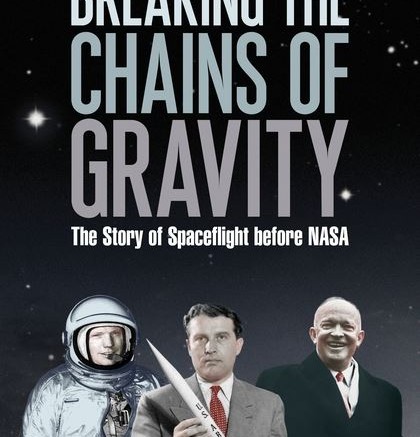Released in the United Kingdom and in eBook format on Oct. 22, and slated for worldwide release on Jan. 12, 2016, Breaking the Chains of Gravity: the Story of Space Flight Before NASA is the debut book of space historian Amy Shira Teitel.
Teitel is well known for her Vintage Space blog and YouTube channel, as well as the host of DNews. She is also a contributor to Discovery News Space, Motherboard, Al-Jazeera, the Guardian, and Universe Today. Additionally, Teitel has made appearances on the the Science Channel, and SyFy.
Just as the title conveys, the book, published by Bloomsbury Sigm, is a historical telling of the events leading up to the establishment of NASA. Teitel focuses on the key figures and events between 1930 and 1958, shortly after NASA was established.
For those who have never explored the history of space flight or NASA, the book makes a great introduction to the topic. Teitel manages to go as far back as pre-World War I rocketry, and covers the key events leading up to the establishment of NASA without losing the reader in overly technical detail. Her narrative is easy to follow, and provides enough details to clue readers in to the significance of various events.
Teitel manages to explore the various fields which advanced in parallel to eventually lead to the first space technology. Aside from rocketry, the advances in hypersonic aviation, sub-orbital flight, human physiology, public perception, and policy are also explored.
For readers who have explored space flight history, Teitel ties the events together nicely in a single book which may present interesting perspective or narrative to key historical events.
Some may be disappointed at the book’s shallow explanation of some events, most notably technical failures or achievements. However, for the general reader, such detail may impede the narrative. Teitel does provide a glossary of people, places, organizations, rockets, and selected notes for readers interested in exploring further.
The book also stops right before things truly heat up during the space race. While Teitel still manages to make all events leading up to NASA’s establishment in 1958 exciting, readers stop dead in the middle of the power struggle for dominance in space between the U.S. and Soviet Russia.
Additionally, the book focuses on space flight primarily from the U.S. perspective. As this is a book about space flight before NASA this makes sense, but some may be left curious about the Soviet side of history.
As a space enthusiast, I found the scope of the book enjoyable; rarely do I read about space history before the capture of Wernher von Braun by the U.S. military after the end of World War II. While I might have enjoyed more technical detail, enough historical detail was provided that the book was not merely a shallow re-telling of the key points in NASA’s pre-history.
To learn more about where, how, and when you can purchase Breaking the Chains of Gravity, look it up on www.bloomsbury.com.





